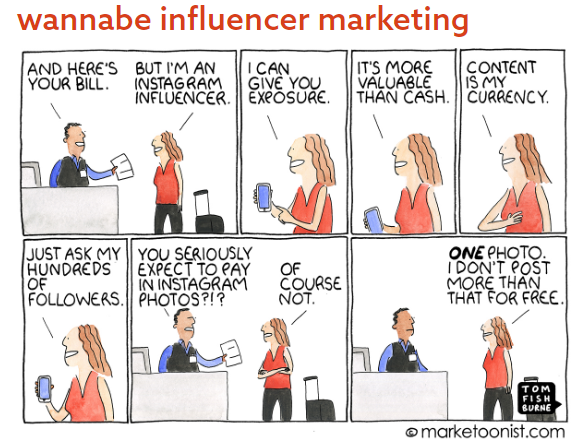With influencers having been the hottest trend in marketing, Adidas is changing things up and seeing influencer marketing evolve.
media update’s Aisling McCarthy looks at how the brand turned influencers into social sellers — and what its effects have been.
What’s influencer marketing again? It involves a partnership between a brand and a social media user with a large following (aka an influencer). The brand leverages the influencer's audience to make sales, and the influencer receives free or discounted products from the brand — or they can be paid directly by the brand.
The problem with influencer marketing, however, is summed up by this
Marketoonist cartoon:
 How much is ‘influence’ really worth?
How much is ‘influence’ really worth?Since no one can really answer that question, many brands have soured to influencer marketing and favoured other marketing tactics that can prove their worth in a simpler manner.
Sportswear brand Adidas has a history of utilising various types of influencers, from NBA All-Star Michel Leroy to virtually-unknown micro-influencers.
On top of this, in 2018 the brand launched a membership programme for its most enthusiastic consumers. The programme, called the ‘Creators Club’, gave members access to products, exclusive drops and special events.
The evolution of ‘social selling’
According to
a Fast Company article by Jeff Beer, Adidas has now taken this relationship to the next level, giving members the chance to sell Adidas products themselves.
On 28 August, the brand announced a new partnership with social commerce app
Storr, which enables anyone to open a store direct from their phone with just three clicks. This concept will begin with 10 000 Creators Club members being invited to become ‘social sellers’.
“Creators Club members who become social sellers will receive a 6% commission from every sale, or have the option to donate to
Girls on the Run, an Adidas partner organisation helping young women reach their fullest potential,” writes Beer.
Chris Murphy, senior director of digital activation at Adidas, explains that social selling makes sense because when consumers look for advice or ideas about where to buy sneakers, they go to their friends and ‘sneakerheads’ who are already in their social sphere.
“We do interesting stuff through Instagram, or through our affiliate marketing, where we’re utilising sneakerheads, influencers and even our athletes to sell our products, because they’re influential and consumers are spending time with them,” he says.
“The next evolution of that is the democratisation of social selling, allowing our consumers to act as wholesalers or retailers on our behalf.”
Adidas’ Creators Club and the move towards social selling is part of the brand’s overarching plans to become more consumer-centric.
“Instead of relying on people to find the right place to buy Adidas after seeing something they like on someone’s feed, this could remove some barriers by letting them buy it right away,” writes Beer.
Influencer marketing is pretty polarising at the moment, with some going as far as to
call the strategy “genius”, and others flat out
saying that “influencer don’t influence anyone or anything”.Adidas’ evolution of influencer marketing could be just what the doctor ordered — a way to include influencers, but still actually put money on the table.
Do you think that social selling is the next step for influencer marketing? Share your thoughts with us in the comments section below.
*Image courtesy of Vecteezy